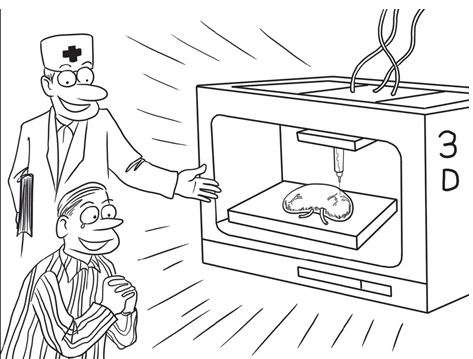 Air Forces arrive at designated area to join China-Russia drill
Air Forces arrive at designated area to join China-Russia drill
 Jumping into sea: People celebrate National Fitness Day
Jumping into sea: People celebrate National Fitness Day
 Old town Dali hosts int'l photography exhibition
Old town Dali hosts int'l photography exhibition
 A brighter future for Sino-Russian relations
A brighter future for Sino-Russian relations
 China has a new 'tallest building'
China has a new 'tallest building'
 Sexy models in CFGP race
Sexy models in CFGP race
 Child labor still remains rampant in war-hit Afghanistan
Child labor still remains rampant in war-hit Afghanistan
 Study reaffirms 'cancer villages'
Study reaffirms 'cancer villages'
 Sun Yang the star of last day at World Swimming Championships
Sun Yang the star of last day at World Swimming Championships
 |
| (Shanghai Daily/Illustration by Zhou Tao) |
3D printing sounds like the stuff of science fiction: a technology that potentially can create any object of one’s imagination, even human organs, with just a few computer instructions.
To “Star Trek” fans, the technology may evoke memories of Captain Picard ordering his favorite cup of tea using a voice-activated replicator on the Starship Enterprise: “Tea. Earl Grey. Hot.”
But 3D printing is real and has generated new excitement these days.
While not exactly a “Star Trek” replicator, a 3D printer uses computer images to make — or “print” — three-dimensional objects.
People can create anything from plastic knickknacks, toys and jewelry to a prosthetic webbed foot for a crippled duck, a human kidney and even a gun — although whether the firearm will work effectively is a matter of debate.
3D printing has been around since 1983 when Charles Hull invented stereolithography, a process that builds objects one layer at a time. The technology was used by industries to rapidly develop prototypes, hard-to-find parts and unique designs.
Businesses saved time and money by being able to construct their own models, no matter how complex the build, instead of sending the job out.
In recent years, home 3D printers have begun to appear. They are simpler to operate, much cheaper and use non-toxic materials. Suddenly, a home factory is within every consumer’s reach.
In February, 3D printing got a boost from US President Barack Obama. During his State of the Union address, he singled out a Youngstown, Ohio, warehouse that was reopened as a state-of-the-art 3D printing lab. Obama said the technology has “the potential to revolutionize the way we make almost everything.”
He announced the launch of three more such hubs and asked Congress to help create a network of 15 sites. Obama was referring to the industrial use of 3D printers to revive America’s manufacturing sector, but the spotlight on the technology helped bring in a rush of products for the consumer market.
In May, office supplies chain Staples announced it would start carrying a 3D printer for consumers called the Cube. Made by 3D Systems, a company founded by Hull, the Cube costs US$1,300 at retail.
A far cry from the stark industrial 3D printers that used complicated computer-aided design software, the Cube is available in five cheery colors and is a “plug and play” device with “no training required,” according to Staples’s website.
In July, eBay launched a 3D printing service called eBay Exact where consumers can order customizable products. Prices range from US$9 for an iPhone case to US$350 for a metal ring. Even Amazon.com has a dedicated “store” for 3D printers and supplies now.
Meanwhile, Microsoft is jumping on the bandwagon by ading support for 3D printers in its upcoming Windows 8.1 update. Making a 3D object from your computer “will be as easy as writing a document in Word and sending it to print,” wrote Shanen Boettcher, general manager of the firm’s startup business group, in a June 26 blog post. “We want this to be so simple anyone can set up their own table-top factory.”
 |
 Chinese troops of "Peace Mission - 2013" arrive at exercise area
Chinese troops of "Peace Mission - 2013" arrive at exercise area Pakistan's rain-triggered accidents claim 29 lives: media
Pakistan's rain-triggered accidents claim 29 lives: media Daily life of auctioneer in Beijing
Daily life of auctioneer in Beijing Top 10 most dangerous jobs in the world
Top 10 most dangerous jobs in the world Weekly Sports Photo: Beauty of Nine Ball; world's 'tallest' couple
Weekly Sports Photo: Beauty of Nine Ball; world's 'tallest' couple Models wear fur clothing in high temperature for ads
Models wear fur clothing in high temperature for ads Day|Week|Month